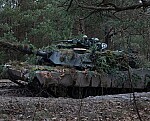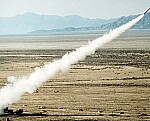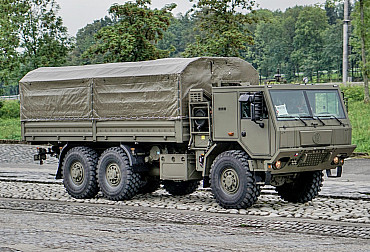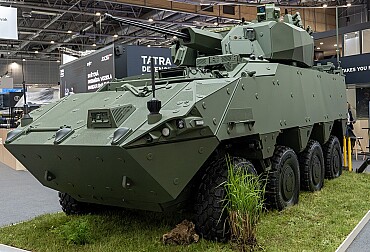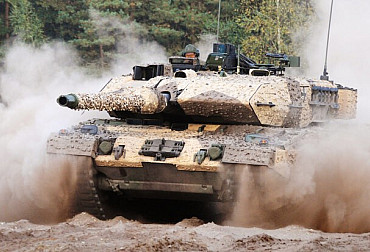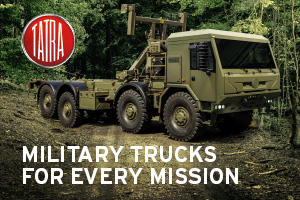The Leopard 2A-RC 3.0 – a modernization program for the old Leopard 2A4s
The world of land defense has seen a major advance with the unveiling of the Leopard 2A-RC 3.0 at Eurosatory in 2024, a prototype main battle tank updated by KNDS Germany. This development marks a turning point in the Franco-German MGCS program, even though the latter has been delayed since June 2024. This innovation responds to rapidly evolving military needs that require solutions that are both modern and adaptable.

The Leopard 2A4 is a widely used main battle tank (MBT) operated by several countries, many of which could benefit from modernization to the Leopard 2A-RC 3.0 standard, developed by KNDS. The Leopard 2A-RC 3.0 introduces advanced features like an unmanned turret, enhanced crew protection, modular armament (120 mm to 140 mm guns), active protection systems (e.g., Trophy), and anti-drone capabilities, addressing modern battlefield threats observed in conflicts like Ukraine.
Technical specifications and new features
The Leopard 2A-RC 3.0 stands out for its impressive dimensions, designed to optimize its performance in the field, unlike other innovations such as the electric propulsion of the K3 tank. Based on the proven Leopard 2A4, it is 7.95 meters long, 3.73 meters wide, and 2.4 meters high, offering remarkably smooth mobility thanks to a 1,500-horsepower engine. This tank can reach a top speed of 65 km/h and has a range of up to 460 km.
One of the most striking innovations is its unmanned turret, which reduces the vehicle's weight to less than 60 tons thanks to the use of lightweight materials. The tank has a 120 mm smoothbore gun equipped with an autoloader on the turret, ensuring a firing rate of up to 18 rounds per minute. Furthermore, its design makes it very easy to integrate 130 mm or 140 mm guns in the future.
Additional armament and interior layout
In terms of armament, the Leopard 2A-RC 3.0 is well equipped. It incorporates a 30 mm remote weapon station, a Spike long-range anti-tank missile module, and even an unmanned aerial vehicle for versatile armament. The interior layout has been designed to maximize safety and efficiency, with a crew consisting of the commander, driver and gunner, all housed in the armored hull.
Enhanced protection and modularity
The Leopard 2A-RC 3.0's protection system is based on the Israeli Trophy system, which provides active defense against a variety of threats. In addition, reactive armor is positioned at the front and sides to reinforce resistance to direct attacks. The tank's modular design allows components such as the main guns to be easily replaced. This not only enables rapid adaptation to the requirements of current conflicts, but also allows all existing variants of the Leopard 2 to be upgraded to this new version.
Prospects and interim offers
While this new tank is being prepared for the future, KNDS has also presented two interim solutions to replace current vehicles such as the Leopard 2 and Leclerc. The first, called “Leclerc Evolution,” offers a concept with four crew members and an ASCALON gun that could be enlarged to 140 mm. The second option is based on the Leopard 2A-RC 3.0 itself, equipped with a compact remote-controlled turret and enhanced anti-tank capabilities. The PT02 prototype was recently presented during maneuvers at a training ground in Saxony-Anhalt, at a time when a major German order to expand its fleet with these new tanks was being discussed.
The arrival of the Leopard 2A-RC 3.0 is much more than a simple technical upgrade; it is a sign that European armed forces are seriously preparing for the challenges of modern land warfare. This new model could well redefine the standards for main battle tanks for years to come, while opening the door to even bolder innovations as part of the MGCS project.
The following countries are major operators of the Leopard 2A4 tanks and could benefit from upgrading to the Leopard 2A-RC 3.0
Germany
Germany maintains a significant number of Leopard 2A4 tanks, though many are in storage or used for spare parts. Active Leopard 2 variants in the Bundeswehr are primarily A6, A7, and A8, but older A4s remain available for upgrades or export. Germany, as the Leopard 2’s home country, has a strategic interest in maintaining a modern armored force. The Leopard 2A-RC 3.0’s modularity and compatibility with existing Leopard 2 chassis make it an attractive option for upgrading stored A4s to bridge the gap until the Main Ground Combat System (MGCS) is fielded. The A-RC 3.0’s unmanned turret and advanced systems align with Germany’s focus on NATO interoperability and countering threats like drones and precision munitions seen in Ukraine. Upgrading stored A4s to A-RC 3.0 would enhance Germany’s reserve capabilities, improve NATO-standard interoperability, and potentially allow for further tank donations to Ukraine without depleting active fleets.
Czech Republic
The Czech Army operates 42 Leopard 2A4 tanks as of 2025, acquired through Germany’s Ringtausch program (exchanging Soviet-era equipment for Ukraine aid) and additional purchases, with 14 more expected by 2026. The 73rd Tank Battalion has fully transitioned to Leopard 2A4s, replacing T-72M4CZ tanks. The Czech Republic is modernizing its armored forces to meet NATO standards, and the Leopard 2A-RC 3.0’s advanced features (unmanned turret, Trophy APS, anti-drone systems) would significantly enhance crew protection and combat effectiveness compared to the A4’s 1980s-era design. The A-RC 3.0’s lower weight (sub-60 tons) and modularity make it a cost-effective upgrade for a relatively small fleet, aligning with the Czech goal of NATO interoperability. Rheinmetall’s maintenance contract (CZK 6.16 billion, €250 million) indicates long-term commitment to the Leopard platform, making upgrades to A-RC 3.0 feasible.
Poland
Poland operates 142 Leopard 2A4 tanks, acquired from German Bundeswehr stocks between 2002–2004 and 2013. These are being modernized to the 2PL standard, which includes upgraded fire control and armor but is less advanced than the A-RC 3.0. Poland’s ongoing 2PL modernization program indicates a commitment to maintaining a relevant Leopard 2 fleet. However, the 2PL standard lags behind the A-RC 3.0’s unmanned turret, multi-caliber readiness (120–140mm), and active protection systems. Upgrading to A-RC 3.0 could address vulnerabilities exposed in Ukraine (e.g., to drones and anti-tank missiles) and align with Poland’s massive military modernization, which includes Abrams and K2 tanks. The A-RC 3.0’s modularity could extend the service life of Poland’s A4s, though cost and competition from other platforms (e.g., KF51 Panther) may limit adoption.
Spain
Spain operates approximately 80 Leopard 2A4 tanks, with some in active service and others stored in Zaragoza. Plans announced in January 2025 aim to replace these with Leopard 2A8s and upgrade Leopard 2E tanks to 2EM variants, but A4s remain in use. Spain’s plan to phase out A4s for A8s suggests a focus on newer variants, but upgrading A4s to A-RC 3.0 could be a cost-effective interim solution, especially for stored units. The A-RC 3.0’s unmanned turret, active protection, and anti-drone capabilities would significantly enhance Spain’s armored forces, particularly for NATO missions. Lessons from Ukraine highlight the need for such upgrades to counter modern threats.
Finland
Finland operates Leopard 2A4 tanks alongside newer 2A6 variants, with an $11 million deal signed with Krauss-Maffei Wegmann (KMW) to upgrade fire control systems starting in 2026. Exact numbers are not specified, but Finland has around 100 Leopard 2s total (A4 and A6). Finland’s ongoing fire control upgrades indicate investment in its Leopard 2 fleet. The A-RC 3.0’s advanced features (unmanned turret, Trophy APS, modular armament) would significantly enhance Finland’s A4s, particularly for territorial defense against Russia. The A-RC 3.0’s lighter weight and anti-drone capabilities align with Finland’s needs in modern warfare.
Austria
Austria operates a small fleet of Leopard 2A4 tanks, with plans to modernize them to the A7 standard, though the exact number is undisclosed. Austria’s planned A7 upgrades suggest a commitment to keeping its Leopard 2s relevant. The A-RC 3.0 offers superior advancements (unmanned turret, active protection, missile integration) that could be more cost-effective than A7 upgrades for a small fleet, enhancing Austria’s limited armored capabilities for NATO or peacekeeping roles.




